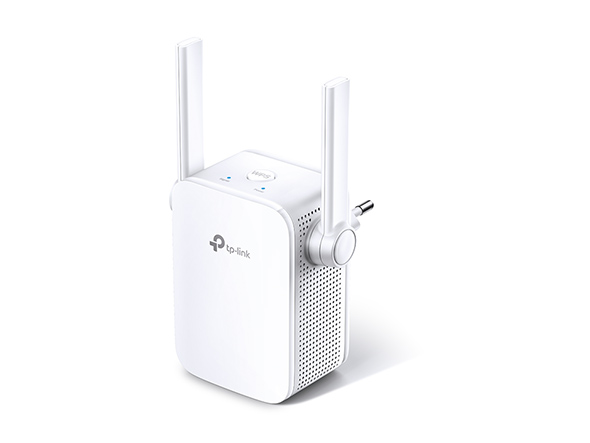TL-WA855RE
300Mbps Wi-Fi Range Extender
- Boosts your existing Wi-Fi coverage to deliver fast and reliable wired and wireless connectivity
- External antennas for faster and more reliable Wi-Fi
- Supports AP mode which creates a new Wi-Fi Access point
- Easily expand wireless coverage at a push of the Range Extender button
- Set the Power Schedule for the range extender for power-saving
- Works with Any Wi-Fi Router
| WIRELESS | |
|---|---|
| Working Modes | Range Extender/Access Point |
| HARDWARE FEATURES | |
|---|---|
| Plug Type | EU, UK, US |
| Interface | 1 x 10/100Mbps Ethernet Port (RJ45) |
| Button | WPS Button, Reset Button |
| Input Power | 100-240V~50/60Hz |
| Max. Power Consumption | 3.6W |
| Dimensions ( W x D x H ) | 3.15 x 3.06 x 3.04 in. (80 x 77.8 x 77.3mm) |
| Antenna | 2 External Antennas |
| WIRELESS FEATURES | |
|---|---|
| Wireless Standards | IEEE 802.11n, IEEE 802.11g, IEEE 802.11b |
| Frequency | 2.4~2.4835GHz |
| Signal Rate | 11n: Up to 300Mbps (dynamic) 11g: Up to 54Mbps (dynamic) 11b: Up to 11Mbps (dynamic) |
| Working Modes | Range Extender/Access Point |
| Reception Sensitivity | 270M: <-68dBm130M: <-68dBm108M: <-68dBm54M: <-68dBm11M: <-68dBm6M: <-68dBm1M: <-68dBm |
| Wireless Functions | Enable/Disable Wireless RadioAccess ControlLED ControlPower ScheduleWi-Fi Coverage |
| Wireless Security | 64/128/152-bit WEP WPA-PSK / WPA2-PSK |
| Transmission Power | < 20 dBm (EIRP) |
| OTHERS | |
|---|---|
| Certification | CE, RoHS |
| Package Content | 300Mbps Wi-Fi Range Extender TL-WA855REQuick Installation Guide |
| System Requirements | Microsoft® Windows® 98SE, NT, 2000, XP, Vista or Windows 7, 8, 8.1, 10, Mac® OS, NetWare®, UNIX® or Linux. |
| Environment | Operating Temperature: 0°C~40°C (32°F~104°F) Storage Temperature: -40°C~70°C (-40°F~158°F) Operating Humidity: 10%~90% non-condensing Storage Humidity: 5%~90% non-condensing |
Maximum wireless signal rates are the physical rates derived from IEEE Standard 802.11 specifications. Actual wireless data throughput and wireless coverage are not guaranteed and will vary as a result of 1) environmental factors, including building materials, physical objects, and obstacles, 2) network conditions, including local interference, volume and density of traffic, product location, network complexity, and network overhead, and 3) client limitations, including rated performance, location, connection quality, and client condition.
The product may not be compatible with routers or gateways with firmware that has been altered, is based on open source programs, or is non-standard or outdated.





